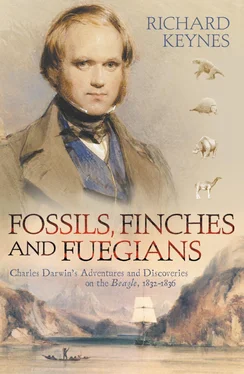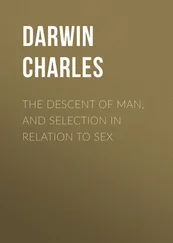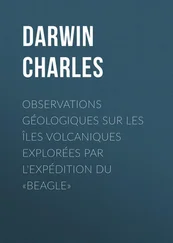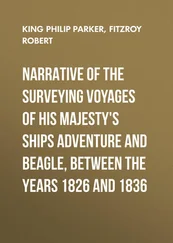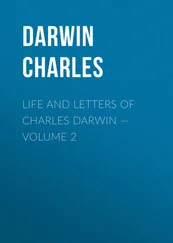On another day he shot a most beautiful large lizard, but he complained that both here and at Rio de Janeiro, birds seemed to be unexpectedly scarce in the tropical jungle. Had he, however, set up a modern mist net in a clearing, and left it unobserved for an hour, he would have been better impressed by the large number of small birds that would have been caught in it.
Confined on board the Beagle by a badly swollen knee for a couple of weeks, Charles captured a puffer fish Diodon swimming in its unexpanded form alongside the ship, and since he was always interested in the mechanics of animal movements, wrote a closely analysed account of its behaviour, as usual unafraid to contradict the authorities if necessary:
On head four soft projections; the upper ones longer like the feelers of a snail. Eye with pupil dark blue; iris yellow mottled with black. The dorsal, caudal & anal fins are so close together that they act as one. These, as well as the Pectorals which are placed just before branchial apertures, are in a continued state of tremulous motion even when the animal remains still. The animal propels its body by using these posterior fins in same manner as a boat is sculled, that is by moving them rapidly from side to side with an oblique surface exposed to the water. The pectoral fins have great play, which is necessary to enable the animal to swim with its back downwards. When handled, a considerable quantity of a fine “Carmine red” fibrous secretion was emitted from the abdomen & stained paper, ivory &c of a high colour. The fish has several means of defence, it can bite hard & can squirt water to some distance from its Mouth, making at the same time a curious noise with its jaws. After being taken out of water for a short time & then placed in again, it absorbed by the mouth (perhaps likewise by the branchial apertures) a considerable quantity of water & air, sufficient to distend its body into a perfect globe. This process is effected by two methods: chiefly by swallowing & then forcing it into the cavity of the body, its return being prevented by a muscular contraction which is externally visible; and by the dilatation of the animal producing suction. The water however I observed entered in a stream through the mouth, which was distended wide open & motionless; hence this latter action must have been caused by some kind of suction. When the body is thus distended, the papillæ with which it is covered become stiff, the above mentioned tentacula on the head being excepted. The animal being so much buoyed up, the branchial openings are out of water, but a stream regularly flowed out of them which was as constantly replenished by the mouth. After having remained in this state for a short time, the air & water would be expelled with considerable force from the branchial apertures & the mouth. The animal at its pleasure could emit a certain portion of the water & I think it is clear that this is taken in partly for the sake of regulating the specific gravity of its body. The skin about the abdomen is much looser than that on the back & in consequence is most distended; hence the animal swims with its back downwards. Cuvier doubts their being able to swim when in this position; but they clearly can not only swim forward, but also move round. This they effect, not like other fish by the action of their tails, but collapsing the caudal fins, they move only by their pectorals. When placed in fresh water seemed singularly little inconvenienced.
The prevailing rock in Bahia was gneiss-granite. * An interesting point was that in the immediate neighbourhood of Bahia, the foliations tended to be lined up with the coastline striking E 50°N, in agreement with the observations of Humboldt in Venezuela and Colombia.
It was at Bahia that one of Charles’s most violent quarrels with FitzRoy arose. When he first landed there he was horrified to find himself in a country that was still a haven for ‘that scandal to Christian Nations, Slavery’ by legally importing slaves from Africa. This practice continued, thanks to the dependence of the Brazilian coffee-growers on slave labour, until it was abolished a quarter of a century later in response to sustained pressure from the British government. Slavery was an issue that always aroused Charles’s strongest emotions, brought up as he had been in a family where both of his grandfathers had played prominent parts in the anti-slavery movement during the last twenty years of the eighteenth century, and which numbered influential Whig campaigners for the abolition of slavery among their friends. Two weeks later, Captain Paget of HMS Samarang , when dining with FitzRoy on the Beagle , regaled the company with horrific facts about the practice of slave owners in Brazil. As Charles recorded in his journal, Paget also proved the utter falseness of the view that even the best-treated of the slaves did not wish to return home to their countries. What Charles did not record at the time, but only revealed much later, was the sequel:
Early in the voyage at Bahia in Brazil, FitzRoy defended and praised slavery, which I abominated, and told me that he had just visited a great slave-owner, who had called up many of his slaves and asked them whether they were happy, and whether they wished to be free, and all answered ‘No’. I then asked him, perhaps with a sneer, whether he thought that the answers of slaves in the presence of their master was worth anything. This made him excessively angry, and he said that as I doubted his word, we could not live any longer together. I thought that I should have been compelled to leave the ship; but as soon as the news spread, which it did quickly, as the captain sent for the first lieutenant to assuage his anger by abusing me, I was deeply gratified by receiving an invitation from all the gun-room officers to mess with them. But after a few hours FitzRoy showed his usual magnanimity by sending an officer to me with an apology and a request that I would continue to live with him. 56
As on other occasions, FitzRoy’s anger was short-lived. Moreover, as he had already shown by his actions, he was always very sympathetic to natives, slaves and underdogs of all kinds, so that his outburst was perhaps more a reflection of his Tory political views than of his true feelings for humanity. Charles’s point was well taken, and when writing from Monte Video to Beaufort in July 1833, FitzRoy said, ‘If other trades fail, when I return to old England (if that day ever arrives) I am thinking of raising a crusade against the slavers! Think of Monte Video having sent out four slavers !!! … The Adventure will make a good privateer!!’ And by the end of the voyage his views on the evil of slavery in Brazil were fully in agreement with those held by Charles. 57
CHAPTER 6
Rio de Janeiro
On 18 March, after taking further soundings for the chart of the Bay of All Saints, the Beagle sailed slowly out in a light wind, and headed for the Abrolhos, a group of uninhabited islets off the coast of Brazil some 350 miles south of Bahia. Five days later the wind was still light, but there was a sufficient swell to make Charles uncomfortable. Occupation was always the best cure, so he settled down at his microscope to examine a mould called mucor growing on ginger from the steward’s cupboard. He wrote in his notes:
Mucor growing on green ginger: colour yellow, length from 1/20 to 1/15 of an inch. Diameter of stalk .001, of ball at extremity .006. Stalk transparent, cylindrical for about 1/10 of length, near to ball it is flattened, angular & rather broarder: * Terminal spherule full of grains, .0001 in diameter & sticking together in planes: When placed in water the ball partially burst & sent forth with granules large bubbles of air. A rush of fluid was visible in the stalk or cylinder. If merely breathed on, the spherule expanded itself & three conical semitransparent projections were formed on surface. (Much in the same manner as is seen in Pollen) These cones in a short time visibly were contracted & drawn within the spherule.
Читать дальше
